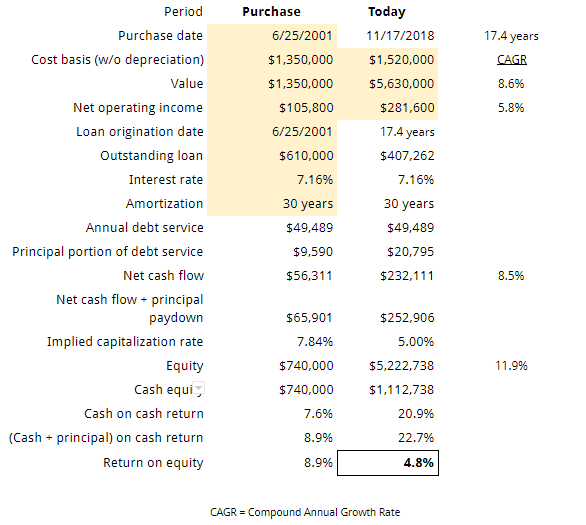Is your equity still working as hard as it should? When you decide to invest in real estate, you invest your time and energy into finding the perfect property and waiting for the right time to buy. Then, after you’ve purchased and financed the property, you shift your focus to managing the property to maximize cash flow. Sounds good and it is. At first.
Time passes. You’ve been collecting rent checks, filling vacancies when they arise, and fixing the occasional toilet. You know that market appreciation has increased the value of your property, and you continue to make your monthly mortgage payments. Both of these factors increase your equity. This, too, is good.
Let’s summarize this good outcome with a hypothetical example:
- You decide to invest in real estate to put your capital to work for you by generating passive income.
- You bought a property at the end of June 2001 for $1,350,000.
- You financed the purchase with a $610,000 loan at 7.16% on a 30-year amortization.
- The property generated Net Operating Income (NOI) of $105,800, indicating a 7.8% capitalization rate against the purchase price.
- You’ve put $740,000 of your capital to work generating net cash flow plus principal recapture of $65,901 generating return on equity of 8.9%.
Fast forwarding to September 2018, let’s see how things look:
- You value the property at $5,630,000 based on a 5% cap. rate and the current NOI of $281,600.
- Over the years, you’ve collected $ in passive income (since this was a goal listed earlier).
- After 17-years of principal payments, you’ve paid down the loan to about $411,000.
- Thanks to market appreciation and continued principal payments, your equity in the property increased from $740,000 to $5,219,000.
Let’s organize these figures into a convenient table:
This is good. Fantastic, even. Looking back, your capital worked hard for you with your equity growing at a compounded rate of 12% per year.
So, where’s the problem? Take a look at the last line item in the table: Return on Equity (ROE). Return on Equity is calculated by net cash flow + principal portion of debt service all divided by your equity. Initially your property generated an 8.9% ROE . However, your current ROE is down to 4.8%. This decrease in ROE is mostly due to faster appreciation of your property value as compared to growth of your cash flow. This is a symptom of compressing cap rates, wherein increasing investor demand for real estate is driving up prices relative to property NOI. This may indicate it’s time to reevaluate things. Would you still buy this property at your current ROE of 4.8%? Most likely not.
So now what? Let’s go back to your goal: putting your capital to work in the highest returning asset you can find. The good news is that you don’t have to give up your current property to take advantage of better return opportunities in the market. Instead you could release the equity with a cash-out refinance of the property.
Now you have a new way to evaluate your current portfolio of property to see if the good decisions you made investing in the past are still good uses of your capital. Tabulate your current ROE and compare it to what you think you could get in the market. Get a perspective from your circle of expert advisors. Perhaps it’s time to take out some equity by refinancing or selling the property altogether and putting your equity to work elsewhere. This doesn’t mean you failed in your attempt at including real estate in your portfolio, it means you’re open to the best way to achieve your goals of maximizing passive income and leveraging your capital/equity/assets. You’ve got options; lots of them.
Your situation may not have obvious answers, but the question remains: is your equity still working as hard as it could be?
